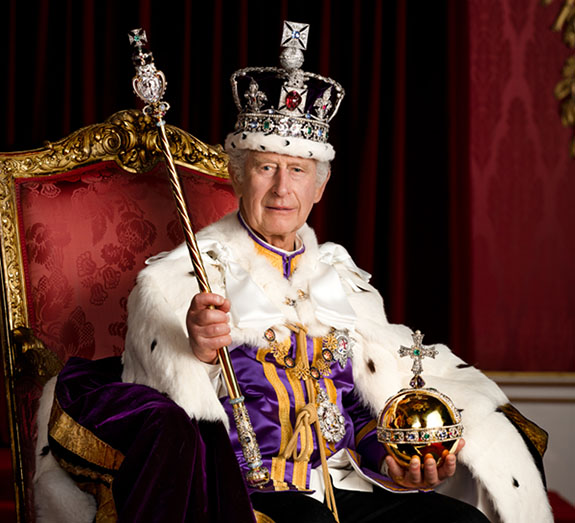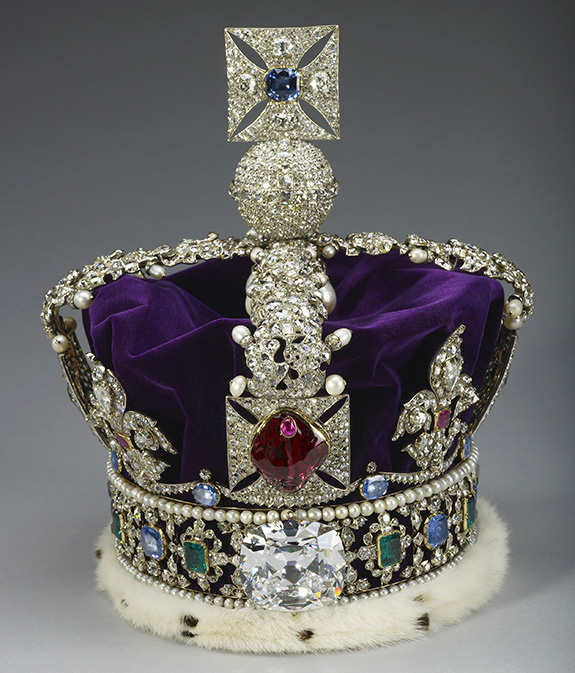If you got up early on Saturday to watch the coronation of Charles III, Britain's first new monarch in 70 years, you may have noticed a curious accessory swap at the tail end of the ceremony.
The St Edward’s Crown was lowered onto King Charles III's head at the "moment of coronation," but then the royal switched to the Imperial State Crown for the final procession from Westminster Abbey back to Buckingham Palace. He also wore it when he appeared on the palace balcony to wave to supporters with other members of his family shortly after.
Considered the centerpiece of the Crown Jewels of the United Kingdom, the St Edward's Crown dates back to the 17th century and was, ironically, fabricated for King Charles II in 1661.
The lavish headpiece glistens with 444 gemstones set in 22-karat yellow gold, but despite its opulence, the piece tips the scales at just under 5 pounds (the weight of a football helmet).
Because of its bulk, the St Edward’s Crown has seen little use during its 362-year-old history and has spent most of its time in the Tower of London. Only six monarchs prior to Charles III had chosen to wear the St Edward’s Crown on their coronations: Charles II (1661), James II (1685), William III (1689), George V (1911), George VI (1937) and Elizabeth II (1953).
Others monarchs opted for more wearable royal crowns. Queen Victoria (1838) and Edward VII (1902), for instance, decided to forego the honor of using the St Edward’s Crown and chose the Imperial State Crown, which weighs just over 2 pounds and features 2,868 diamonds and colored gemstones, including 17 sapphires, 11 emeralds and 269 pearls.
Charles III decided to wear both. At the end of the coronation ceremony, he switched to the less ominous Imperial State Crown, also called the "working crown." He also chose to wear it for his official portrait, shown above. The photo, above, shows the king in full regalia, holding the Sovereign’s Scepter in one hand and the Sovereign’s Orb in the other.
Jewelry experts put the value of the three bejeweled items at more than $6 billion.
Designed by Garrard & Co in 1937, the Imperial State Crown is highlighted by three noteworthy gems. At the front of the crown band is the famous Cullinan II, a 317-carat cushion-shaped diamond that is also known as the Second Star of Africa. The diamond is set just below the 170-carat Black Prince's Ruby (actually a spinel). At the back of the band is the 104-carat "Stuart Sapphire."
Earlier in its history, the irregularly shaped Black Prince's Ruby had been drilled so it could be worn as a pendant. As seen in the photo, the unsightly hole was filled with a cabochon-cut ruby in a bezel setting.
Cullinan II is the second largest stone cut from the 3,025-carat Cullinan Diamond, the largest diamond ever discovered. The Cullinan I, also known as the Star of Africa, weighs an incredible 530 carats and is mounted atop the Sovereign's Sceptre.
The Sovereign's Sceptre with Cross dates back to 1661 and is adorned with diamonds, emeralds, rubies, sapphires, spinels and amethysts. The sceptre comprises a golden rod, formed in three sections, with enameled collars at the intersections. The enameled heart-shaped structure that holds the Cullinan I is hinged so that the stone may be removed and worn separately, although this has been done rarely, according to the Royal Collection Trust.
Mounted with clusters of emeralds, rubies and sapphires surrounded by rose-cut diamonds and single rows of pearls, the Sovereign's Orb also dates back to 1661. It symbolizes the Christian world with its cross mounted on a globe. During the coronation service, the Orb is placed in the right hand of the monarch and then on the altar before the moment of crowning.
Credits: Official portrait by Hugo Burnand, courtesy of Royal Household 2023. Crown photos courtesy of Buckingham Palace.



No comments:
Post a Comment